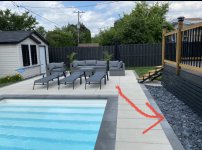- Jul 4, 2023
- 11
- Pool Size
- 6300
- Surface
- Fiberglass
- Chlorine
- Salt Water Generator
- SWG Type
- Hayward Salt & Swim 3C
This is our third time this summer where the water turns that slight teal green colour and our white walls turn yellow. Did the AA treatment each time, but this is the first time the water remains green. Brought TC to zero, put in some “HTH Extra 60%” algaecide, dumped in the AA and let it circulate until walls were white. Then put in a bottle of “Atlantis Metal Remover” and let it filter for 24h. Then put a Culator in the skimmer and even emptied out about a third of the pool to help eliminate some of the “bad” water and. It’s been 3 days and water colour has not changed one bit. Not worse, but not any better. After reading about 482 threads on here  we also filled an old stocking with Polyfill and put that in the skimmer too today. Started to see a few spots of algae on the walls and water is slightly cloudy so we put the SWG back on and have it on the max setting. We also have no idea where the iron is coming from! We are in the suburbs of Montreal with city water (no well). Had the pool installed in 2021 and this is the first summer this happens. Have not been able to find any place here that does proper water testing and the strips we got on Amazon are worthless. How do we get the water blue again, and how can we find the source of this iron?? At this point we are considering converting this thing into a giant vegetable garden
we also filled an old stocking with Polyfill and put that in the skimmer too today. Started to see a few spots of algae on the walls and water is slightly cloudy so we put the SWG back on and have it on the max setting. We also have no idea where the iron is coming from! We are in the suburbs of Montreal with city water (no well). Had the pool installed in 2021 and this is the first summer this happens. Have not been able to find any place here that does proper water testing and the strips we got on Amazon are worthless. How do we get the water blue again, and how can we find the source of this iron?? At this point we are considering converting this thing into a giant vegetable garden  thanks in advance!
thanks in advance!



 You appear to have two problems right now - iron and algae. When that happens, you must treat the algae first via the
You appear to have two problems right now - iron and algae. When that happens, you must treat the algae first via the 

